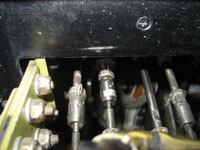Small Changes Can Make a
Big Difference

By Geoffrey Pence,
Customer Service Manager, Twin Commander Aircraft


Sometimes it�s the small things that make a big difference. Take the small nut that secures each steel-strand cable to power and condition levers on the power pedestal in Twin Commander turboprops. The cables provide a mechanical connection from the power levers to engine control accessories, thus enabling the pilot to advance or retard power and prop rpm. Eight such cables snake out from the power levels beneath the pedestal covering to the engines, which means there are eight nuts. The securing nuts also function as seals to prevent pressurized air from seeping into the cable sheathing and venting on the engine side of the cables. When those seals begin to wear, cabin pressurization is affected, with the result that cabin altitude goes up.
Maximum cabin pressurization differential is achieved only when every avenue of escape in the pressure vessel is blocked with some sort of seal. When those seals become worn, pressurized air has a path to vent to lower-pressure ambient air. Pressurization suffers, as evidenced by a lower-than-maximum pressurization differential and higher-than-normal cabin altitude indication on the cockpit gauge.
It doesn't take much of a leak to compromise the pressurization system. A single #10 screw missing from the floorboard leaves a small hole, but it's still large enough to vent enough cabin air that it can be discerned on cockpit gauges.
A worn seal on an engine control cable nut has another consequence that can turn out to be a bigger deal than loss of pressurization differential. Pressurized air seeping past the nut seal contains moisture�the more people in the cabin the greater the moisture content of the cabin air�and in the sub-zero ambient temperatures encountered at flight-level cruise altitudes, that moisture can freeze. At best the frozen moisture inside the engine control cables will lead to binding of the cables; at worst it will freeze the cables in place and the pilot loses control over engine power. This has occurred. The pilot's only recourse is to descend�at cruise power�to an altitude where the frozen cables can thaw.
Contaminant- and moisture-laden air seeping into the cables also tends to flush away lubricant, contributing to a stiff feel to the power levers and accelerated cable wear. The engine control cables can be serviced to restore lubricant. Nitrogen is injected into each cable to purge the moisture, and new lubricant is pumped in. This may free up the cables, but it also may amount to just buying time. If the cable nut seals are worn the binding likely will return.
One operator who had experienced the ratcheting feel symptomatic of well-worn cables had the cables replaced, only to have them stiffen up again. Further investigation revealed that the nuts securing the cables to the power levers had worn seals. The best solution to the problem of stiff power levers is to replace cables and nuts, and thanks to a recent innovation that makes more sense than ever.
When the supplier of the replacement engine control cable nut was asked to manufacture a new batch, the price quoted was unacceptably high. So Twin Commander Aircraft designed and cycle- and pressure-tested a new version that has been approved for production. In addition to holding the line on pricing, the new replacement nut should do a better job of maintaining an effective pressurization seal over the useful life of the part. The engineer in charge of the project commented that the more cycles applied to the control cable nut, the better the pressurization seal performed.
The first production run was just being wrapped up as this was being written. Twin Commander is drafting a service letter that will call for inspecting engine control cables, and checking the condition of the existing control cable nuts to ensure each is sealing properly�and that it is indeed the correct part. Hard to believe, but we've seen instances where the plastic nut applied to the end of the engine control cable to protect the cable end during shipping has mistakenly been installed on the airplane. The correct procedure when installing new cables is to pull the shipping cap off and use the existing seal nut or a new replacement.
It may be a small and insignificant part in the big picture that is a Twin Commander aircraft, but the new engine control cable nut is an example of our initiative to identify parts in need of a fresh look to improve their functionality without increasing the cost to operators.
Discuss this article in the forums...







